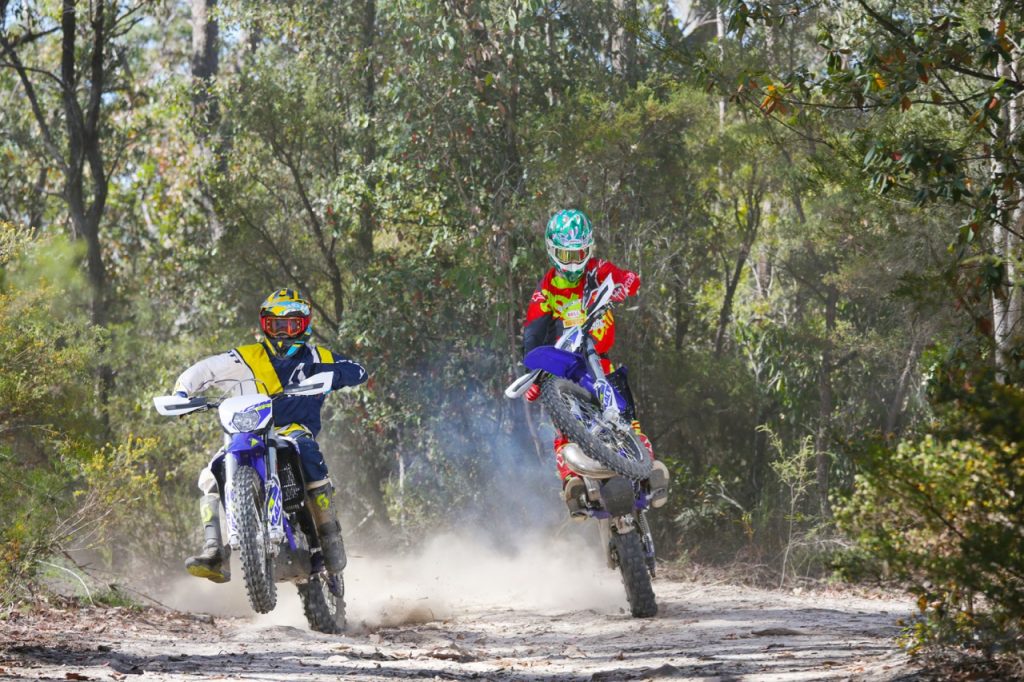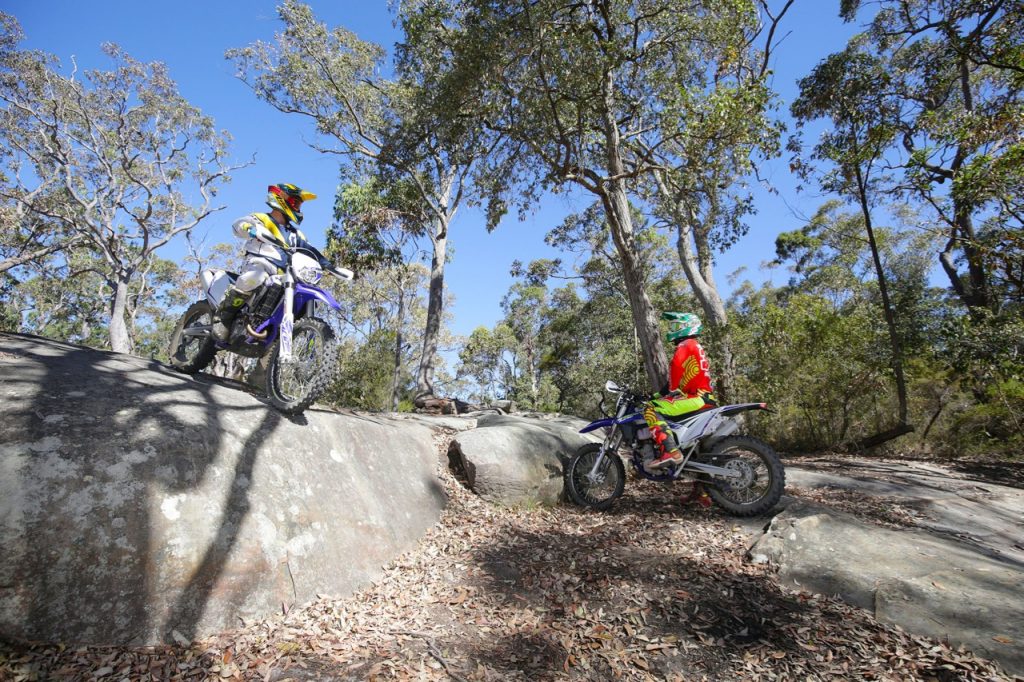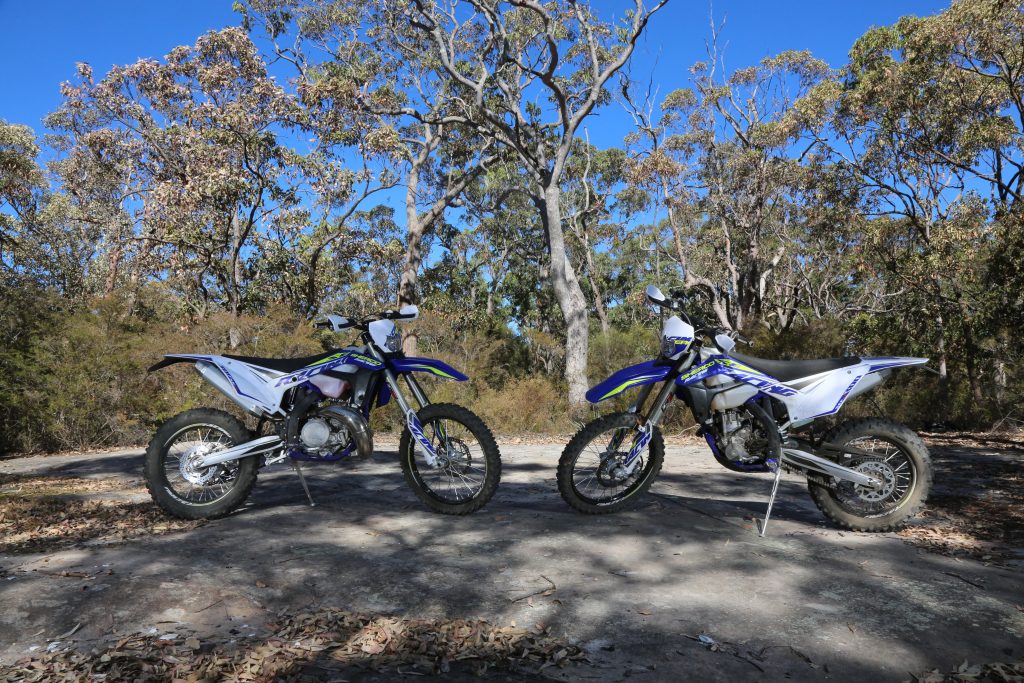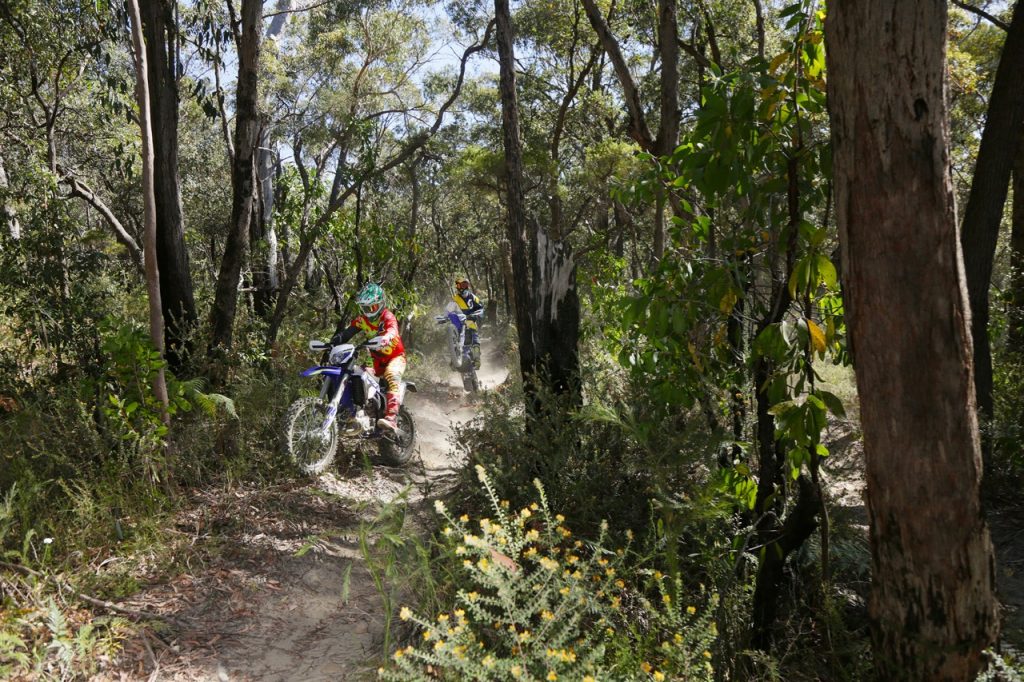This feature was first published in ADB issue #462 – April 2018
Words: Geoff Braico
Photos: Mitch Lees
It’s quite amazing that two bikes with the exact same capacity, can be so different. And the best part is that every year, these two types of bikes get better and better. There is only one manufacturer that produces both a 300cc two-stroke and a 300cc four-stroke and that’s Sherco. The French crew have been hard at work over the last few years developing their 300s and I’m riding them back-to-back and, I guess, adding some fuel to the fire in the great smoker versus thumper debate. We answered this debate for motocross bikes in issue #449, now it’s time for enduro.
COMPARING NOTES
The bikes look identical, but as you read through the specs, you find a couple of interesting differences that could come into play on the track. First up, your bank account will thank you for choosing the two-stroke as it’s around $1000 cheaper. That $1000 difference could easily be swallowed if you were to smash the FMF expansion chamber a couple of times out on the trail. Those bad boys aren’t exactly cheap and, from my experience, four-stroke pipes are easier to keep looking pretty.
An interesting spec I came across is the Sherco claim that the 300SEF-R is lighter than its two-stroke brother. At 102kg (claimed dry), its apparently 3kg less than the 2T, and it will be lighter again full of fuel as its tank is only 9.7 litres, versus 10.4 litres for the SE-R because of the fuel pump. Both bikes have electric start with the same battery and no kickstarter so that shows that Sherco has plenty of faith in its system. Both have a WP open-chamber fork and WP 46 shock so it would be interesting to see if the engine braking of the four-stroke changed the feel between the two.

Plastics are interchangeable, as are the wheels, and while that doesn’t seem like a big deal to most people, it is a smart feature. If you were to buy a new bike and then splurge on a set of wheels, it does come in handy when they fit other models. Lastly and probably the coolest fact is that Sherco offers both these models in their upgraded Six Days and Factory Editions and while these are more expensive than the stock bikes, they come with a heap of bling and performance parts.
OUT ON THE TRACK
The first bike I rode was the 300SE-R. I’ve had a soft spot for 300 two-strokes ever since I first rode one back in 2007. The torque that they produce and the power-to-weight ratio is very appealing and that is why they are so sought after for extreme enduro craziness.
The 300SE-R is a powerhouse, it produces strong yet useable power but, with the flick of the clutch, you are heading down that trail at high speed. I like the feel of the motor but I can see a less-experienced rider getting themselves into a bit of strife. The corners come up on you so quick when you are going for it, and having no engine braking can be a scary scenario. I even had a few moments where I got throttle happy railing a corner and then couldn’t quite pull up in time for the next one.
Of course, I’m referring to race pace when I mention overshooting corners but out on the trail just cruising along, the 300T is damn nice to ride. Stand up out of a corner, click second, click third and it feels like you can just ride all day. I really enjoyed the two-stroke on singey, especially when it got technical. You could pretty much ride the bike at almost no revs and it would crawl out of any situation with ease.

It’s easy to explore different lines through difficult sections of the trail on the two-stroke, especially if you have good throttle control, because the torque will keep you from wheel spinning and/or getting stuck on something such as a gnarly hill.
The torque and grunt of the 300 smoker is the biggest fun factor for me. Having that ability to go from trailriding with little to no revs to getting on the clutch and launching over a log or erosion mound is something you don’t get on a four-stroke. And the sound it makes when you do that is brilliant! It makes that well known ‘Braaap’ noise that you then repeat over and over in your head every time you do it and again when you describe it to the boys when you stop. And now that you’ve read that last sentence, tell me I’m wrong!
FOUR-STROKE
The 300 four-stroke is also a hell of a lot of fun. Obviously, for starters, it doesn’t sound as good as the two-stroke but it still has a nice exhaust note that isn’t overly loud but still quite throaty. The 300SEF-R has a nice motor with its strong point being its low to mid-range power.
If you are a short-shifter who likes to ride in a higher gear, then the SEF-R will oblige but, let’s be honest, it prefers to be unleashed. The motor likes revs and the whole bike performs better when you ride with some intensity. Rev it to the moon, blow out your berms, slap those valves around a little, the 300 SEF-R loves it all!
I think that Sherco has built this bike with the racer in mind more-so than the trailrider. Now I don’t mean that it will rip your arms off or feels harsh on the smallest bumps or anything like that, I just mean that the way the bike needs to be ridden will suit someone who wants to go fast. It still is a fantastic bike to go trailriding on, but Sherco has built this bike to go fast. It is much more at home in the rough stuff that’s for sure. You can point and shoot between corners without worrying about getting too out of shape and that essentially makes it less tiring on the rider.
There is less vibration coming through the ’bar on the four-stroke as well and that helps a lot if you are one of those riders who gets arm pump at the thought of going for a ride. After spending a good hour or so riding the two-stroke, it was nice to get on the SEF-R and ride with minimal vibration and no arm pump.

COMPARE THE PAIR
It is pretty crazy how different these bikes feel. At race pace and coming straight off the two-stroke where I felt like I had to be patient with the power, the 300F felt like I could hop on and ride it as hard as I wanted. Like I said earlier, the 300F needs to be revved and wants to be pushed along the trail as fast as the rider can handle whereas the two-stroke is all about precision and getting your lines right.
You have to employ a different attitude on the track on the four-stroke. Rather than pushing along and being a tad cautious on the smoker, the 300SEF-R makes you want to charge into the corner and crank into the ruts or berms as fast as you can.
That being said, if you pay attention to the motor on the SE-R and learn how to embrace the extra grunt, it can be ridden just as fast, if not faster, than its little brother. It just takes a little more finesse and concentration.
Again, I’m mainly referring to race pace here with these points. As far as trailriding goes, I believe the two-stroke is easier to ride. You can be a lot lazier with the power on the big two-smoker, use the torque to short shift everywhere and it will get you home no problem. It will climb anywhere you want to in third gear and you’ll be loving every second of it.
Suspension and handling-wise, the 300SEF-R is a tad easier than the two-stroke as it feels more planted. The SEF-R didn’t dance around as much as the two-stroke, especially on my rough test track and I could link the corners better and find a good flow. But I do like that you can get out of the corners faster on the 300T and get on top of the bumps easier. Once you hit that clutch, you’re off and skimming along that trail with ease.

They have the same suspension package with no spring or valving differences, so it was interesting to witness how they soaked up certain sections of the track. They both are softer than I’d like but, for the average guy out there, they will feel pretty good. Sherco has come a long way with its suspension.
It is pretty common to hear someone say, “Two-strokes need less maintenance” and in many cases, this is correct. I can strip a two-stroke by myself and rebuild the top-end in one night with no dramas whereas I haven’t got the slightest clue how to change the top-end in a four-stroke.
I’ve seen it done plenty of times but there is a lot more going on and I don’t have the confidence to rebuild one. The good thing is that once you get your head around the two-stroke top-end, you can pretty much work on any 2T. Try rebuilding a 125, it feels like it takes 15 minutes!
VERDICT
So when it is all said and done and I’ve done all my laps and had my fun, which bike would I pick? Well, both bikes are solid and both have their pros and cons. Both are loads of fun to ride and both are reliable. It’s a tough choice but I honestly must say I’m 50/50 and would have either. I don’t have a favourite but I will say that I would race the four-stroke and trailride the 2T. I love that I can push as hard as I want on the SEF-R and not get tired and I love that I can ride the two-stroke into and out of any hard situation.
I have been lucky enough to ride a huge range of two-strokes and four-strokes over the last 15 years and, sure, there have been standouts but I honestly believe it comes down to personal preference when choosing between the two. I believe that any calibre of rider would enjoy riding either of these bikes.
There are diehard two-stroke guys out there and diehard four-stroke guys but the gap between the two as far as rideability and enjoyment is very small. I prefer to look at it like this, they’re both better than going to work!









